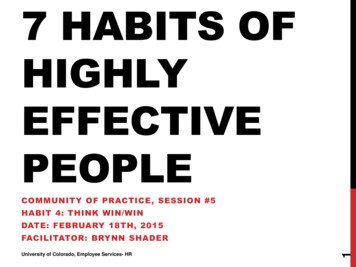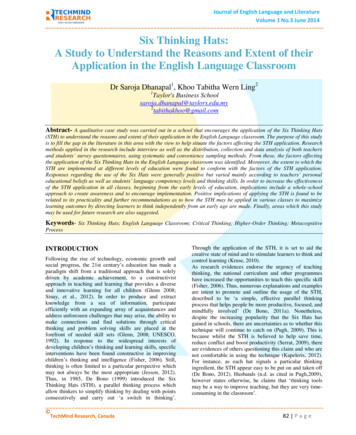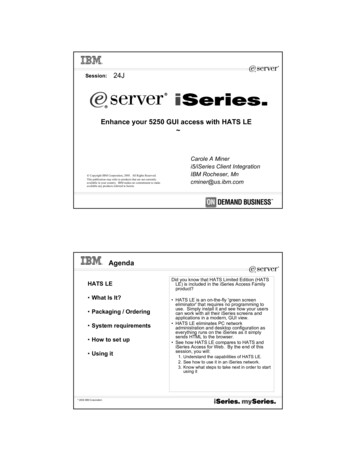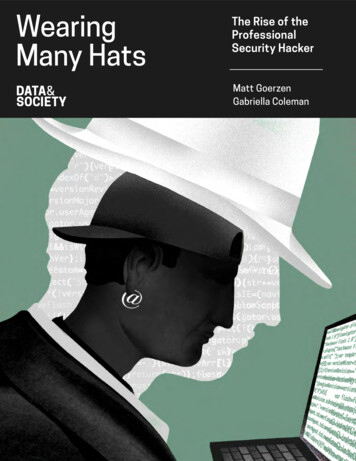
Transcription
Why Black Hats Always WinVal Smith (valsmith@attackresearch.com)Chris (chris@sdnaconsulting.com)Slide: 1
BiosVal Smith– Affiliations: Attack Research Metasploit– Work: Attack Techniques ResearchPen Tester/ Exploit developerReverse EngineerMalware AnalystPrevious Talks– Exploiting malware & vm detection–––––Kernel mode de-obfuscation of malwareData mining malware collectionsTactical ExploitationPost ExploitationAnalysis of foreign web attacksSlide: 2
BiosChrisChris is a Security Consultant and Researcher with SecureDNA. Chris specializes in web based applicationdevelopment security. He has collaborated with some ofthe top security researchers and companies in the worldand has performed static and dynamic securityassessments for numerous companies and governmentagencies across the U.S. and Asia.Slide: 3
What are we talking about? Overview of:– White hat Methodologies– Black Hat Methodologies Attackers VS. DefendersAnalysis of Black Hat techniques in the WildBlack Hat Methodologies DemystifiedHow can this help you?What can you do?Slide: 4
Overview of White Hat MethodologiesSlide: 5
Overview of White Hat Methodologies Goals– Focus on racking up numbers of hackedmachines– Data to fill reports– Identifying mitigations How to prevent the attack– Vulnerability footprint, not penetration Often identifying accessible data is secondarygoalSlide: 6
Overview of White Hat Methodologies Goals– No downtime for the customer DoS usually not allowed Even if it facilitates access via reboot, etc.– No modifications Typically can’t change:– Customer source code– Databases– Testing the response and detection mechanisms Did the IDS catch us? Did they do anything?Slide: 7
Overview of White Hat Methodologies Information Gathering– Heavy focus on scans Massive NMAPs / Nessus normal– Some overlap with Black Hat's DNS / Domain lookup records Google hacking Personnel googling– Less concern for detectionSlide: 8
Overview of White Hat Methodologies Vulnerability Assessment– Almost always automated scanners Detectable & fingerprintable– Often a guess at potential vulnerability– Focus on risk & threat analysis Vulnerability Consequences– How does this hurt client business– Do they stand to lose money / customers?– How likely is attack to occurSlide: 9
Overview of White Hat Methodologies Exploitation– Download and run exploits from milworm Now defunct How many pen test shops does this put out ofbusiness?––––Securiteam & Security FocusCore Impact / Canvas / MetasploitMatch up with nessus resultsUsually no testing, run live against customerSlide: 10
Overview of White Hat Methodologies Data Collection– Screenshots– Sample documents Just enough to prove access– No Analysis of attack paths– No prolonged infiltration No long term sniffing / keyloggingSlide: 11
Overview of Black Hat MethodologiesSlide: 12
Overview of Black Hat Methodologies Goals– Wide ranging– Data, not just access focused– Targeting specific trusts People weakest link in trust chains– Semi-unrelated access that may providestepping stone 6 degrees of separation Any box on any network 6 degrees away from truetargetSlide: 13
Overview of Black Hat Methodologies Goals– Access to source Let THEM do the hacking for you– They infect their own systems with backdoored updates Source enables more assets– Example: Target runs wordpressBlack Hat owns wordpress source serverAudit & Backdoor codeSurefire ownage of ultimate target in timeSlide: 14
Overview of Black Hat Methodologies Information Gathering– Nothing is off limits– If needed info resides on unrelated box its still in scope– Social networking– Call up target and ask for info Call targets friends, co workers,familySlide: 15
Overview of Black Hat Methodologies Vulnerability Assessment– Attacker’s often know what’s vulnerable ahead oftime No need for noisy scans– More efficient method than white hat’s trial &error– Stolen source code Trojaned Audited for 0daysSlide: 16
Overview of Black Hat Methodologies Vulnerability Assessment– Non-traditional vulnerabilities– Example: Software distro & licensing applicationIn house written by targetInstalled on every computerRuns with domain admin account privilegesPassword changed every x min time interval– Accessible clear text in memory with debugger Domain admin access to any machine for x minutesSlide: 17
Overview of Black Hat Methodologies Exploitation– 0 Days Often only used when public bugs don't work Avoid risking burning unpublished bug if possible– Usually interception from another box is better– Ex. Metasploit usually waits for 0day to becomepublic before trunking– Wait till bug becomes 1day then blend in withworm trafficSlide: 18
Overview of Black Hat Methodologies Data Targets––––––Mail spoolsBackup filesDatabase dumpsSniffer logsKeystrokes and chat logsAccess tokens Crypto keys, kerberos tickets, windows domain tokens– Targets of opportunity Maybe data xyz is the goal but abc is found more valuableSlide: 19
Overview of Black Hat Methodologies Data Theft– Client Injection / Exploitation Vulnerable Client Applications– BSD IRC client exploit Browsers– Grab sensitive data in browser POST» Before its SSL encrypted on screen keyboards useless– Backdoors Access Points Services UtilitiesSlide: 20
Attackers vs. DefendersSlide: 21
Attackers vs. Defenders Defenders: Attackers:– Limited resources– Unlimited resources– Limited time– Unlimited time– Rules of engagement– On a long enough timelineeverything gets owned– Consequences based onperformance If a pen tester never gets in,they stop getting hired– Motivation– If attacker targets you, oddsof success increase over time– No consequences to notgetting in– Little to no rules– MotivationSlide: 22
Attackers vs. Defenders White Hats usuallyassigned limitedblock of IPaddresses Unable to gobeyond the scopeof approved list Black Hats usuallyknow one piece ofinformation andhave to expandfrom there– Domain Name– Email addressSlide: 23
Attackers vs. Defenders Black Hats need techniques fordiscovering target related IPs and clientside info––––News group mail header harvestingProxy log analysis site miningBackscatter spamBotsvsbrowsersSlide: 24
You know thetarget’s domainnameLook at the IPrangeUnlikely to bethe target’soperationalLANSlide: 25
Searching newsgrouppostings for the targetdomain yields an emailbounce with headersHeader shows the IPthe email was sentfromLikely to be the targetLAN or a home IP of auser on the target LAN(vpn maybe?)Sometimes theheaders in mailing listposts themselves havethe same infoSlide: 26
Check the IP theemail came fromTotally differentnetwork, in thetarget countrySlide: 27
Search for filetypesassociatedwith mailboxes togather clientsideinformationSlide: 28
Slide: 29
Botsvsbrowsersgives you by IPaddress clientinformationsuch asbrowser andoperatingsystemSlide: 30
Some sites haveexposed squidproxy loganalysis pagesIn this view youcan see somehostnames andinternal IPaddressesSlide: 31
This viewshowsuserIDsand trafficquantitiesSlide: 32
This view showsaddresses aparticular user isbrowsing toSlide: 33
This viewshowsinternal IPaddressesSlide: 34
Shows whatAntivirusprogram thetarget isrunning andhow often theyupdateSlide: 35
Shows thattarget isrunningMicrosoftwindows andgives hints asto whatupdates arebeinginstalled aswell asfrequency ofupdateSlide: 36
Analysis of Black Hat Techniques in the WildSlide: 37
Profiling How White Hats getassigned Targets:– "Only touch xyzhosts, don't touchabc, those areproduction“– "Hosts 123 wealready know arevulnerable, don'tworry about those" How Black HatsChoose Targets:–––––Source code devsPen testersResearchersMaintain ControlMay not yield accessimmediatelySlide: 38
Analysis of Black Hat Techniques in the Wild Environment Modeling & Testing– White hats test attacks against clients– We have seen whole environments mirrored– Base mock up on info gathering Match OS, hardware, patch levels, applications Virtualization up to real hardware Exploit Development– Black Hats write them– White Hats use themSlide: 39
Analysis of Black Hat Techniques in the Wild Flexible Environment Testing– Can do vulnerability assessment at leisure Code auditing– Double win: 0day 0wnage Fuzzing Reverse Engineering / Binary Analysis– Exploit testing without alerting target– One case was 18 months of staging Less than 1 minute of exploitation 5 minutes of data stealingSlide: 40
Analysis of Black Hat Techniques in the Wild Examples––––––Attack on Apache.orgAttack on Debian.orgAttack on Wordpress.comAttack on Comcast.netAttack on Linux DistroAttack on BankSlide: 41
Analysis of Black Hat Techniques in the Wild Apache.org– Attackers used no exploits. Instead they reliedon configuration errors– Used a combination of small bugs leveragedagainst the system to gain– Administrative access to the main sourcerepository– Patiently waited for root to login.– DefacedSlide: 42
Analysis of Black Hat Techniques in the Wild Debian.org– Attackers used no exploits.– SSH Authkey misuse on a system in Japan anda system in the Netherlands– Allowed access to the administrative account ondebian.org– SSHD backdoored and core debian OS sourcebackdoored– Was unknown for 6 monthsSlide: 43
Analysis of Black Hat Techniques in the Wild Wordpress.com– Attackers used zero day vulnerability– Backdoored Live web application– Accessed chief source coderepository– Backdoored source code– Was quickly noticed and fixedSlide: 44
Analysis of Black Hat Techniques in the Wild Comcast.net– Attackers used no exploits– Attackers Social Engineered NetworkSolutions into granting them access toComcast's account– Attackers redirected comcast.net domainname to attacker controlled servers– DefacedSlide: 45
Analysis of Black Hat Techniques in the Wild Major Linux Distro– Heard of attacker getting in overmonths– Subtlety backdoored distro Introduced bug– Matched md5s– Able to own any system for 6 months– Distro NOT the ultimate targetSlide: 46
Analysis of Black Hat Techniques in the Wild Hackme Bank– Found devel host on separate network– Attackers used custom vuln in co-located website– Read many files via directory traversal Solaris treats directories like files– So you can do cat dir/ and get an ls– Discovered copy of every transaction goes overemail– Copied mail spool via targets own website– Slide: 47
Analysis of Black Hat Techniques in the Wild Air Gap– Difficult to hack network w/ smart admins– Attackers did recon, read target procedure docs Two networks– One online, heavily monitored– One offline exact copy cold backup– One tape drive machine for copying back and forth– Compromised tape system (nothing else vuln) Found 0day in unix TAR Generated a malicious TAR file header Payload wrote malicious binaries into archiveSlide: 48
Analysis of Black Hat Techniques in the Wild Air Gap– Exploit had to reload TAR and start untarring from anoffset pointing to valid archive Execution continuation– Admins eventually moved trojaned backups to “cold” side– Attacker made loud (but ineffective) attacks on “hot” side– Admins assumed compromise and restored “hot” sidefrom cold backups Thus trojaning their own systems and giving attacker accessSlide: 49
Analysis of Black Hat Techniques in the Wild Banking backbone– Attacker stumbled upon system while doing x25 scans– Old ftp / ftp uname & password trick worked for a shell– Attacker poked around system and noticed financialtransactions LARGE amounts of money Grabbed docs and logged out– Turn out to be major banking transaction system All transactions encrypted, but banks would ftp transaction logs toserver and store them clear text for balance reconciling– By coincidence attacker met system owner in real life– Caused no damage, but spent a year hidingSlide: 50
Analysis of Black Hat Techniques in the Wild University– Attacker compromised system at major university– Forensics discovered the compromise– Attacker used a kernel rootkit years before common Investigators assumed nation state sponsored attack It wasn’t Rootkit removed– Attacker spent 6 – 8 months designing a bios rootkit– Re-compromised system and went undetected with newtechnique– Illustrates persistence of some attackersSlide: 51
Black Hat Techniques De-MystifiedSlide: 52
Black Hat Techniques De-Mystified Few exploits used in attacks– Often only 1 exploit needed– Rest is captured passwords– Trust hijacking– Using compromised user's access Datacenter / SSH example authorized keys infectionSlide: 53
Black Hat Techniques De-Mystified Few exploits used in attacks– Looking like a normal user is hard to detect No shellcode / payloads for IDS to see Traffic looks like normal user activity– 0day is priceless Often used when 1day– Greater knowledge of system internals is key– Attackers know your playbook Blackhats don't do what pen testers do (Unless they want to look like you)Slide: 54
Black Hat Techniques De-Mystified Problems attackers run into– Secure Data Exfiltration– Dangerous Data Mail spools full of viruses Smart targets, documents with attribution call homes Trojaned TAR files– Built to overwrite home directories– Burn data to CD– Read offline on throw away box Avoids above problemsSlide: 55
Black Hat Techniques De-Mystified Problems attackers run into––––––Retrieving GB's over TorDownload managers not just for warezScripted Tor wget'sPOST's instead of GET'sObfuscates logsHow to get reverse shells back withoutattribution?– Leaking info during attack (emails / chats)Slide: 56
Black Hat Techniques De-Mystified Maintaining Control– Data Interception is priority number one. Let the victims do the hacking for you– Why use rootkits Detectable Kernel behavior almost always indicates 0wnage– Better to ensure re-exploitation at will– Hide in plain site / look like normal activitySlide: 57
Black Hat Techniques De-Mystified Maintaining Control– Introduce subtle bugs instead of backdoor binaries– Modify source to be vulnerable Harder to detect than blatant backdoor– Downgrade applications to vuln versions– Re-enable disabled accounts– Keep admins & incident response second guessing Flood box with worms & malware if you don't get in Hide in the noiseSlide: 58
Black Hat Techniques De-Mystified Maintaining Control– Example:– Machine has VNC installed– Replace installed VNC with vulnerable version Authentication bypass– Copy registry password so target doesn’t realizesoftware has been updated– Persistence with no malware or rootkits to getdetectedSlide: 59
Maintaining Control– Add vulnerable code– Example: web apps Take out user input validation Inject your vulnerable code– Focus on vague intent– Never be obviously and solely malicious Look for apps with previous vulnerabilities Re-introduce patched bugsSlide: 60V
Maintaining Control– More web app examples– Add hidden field to HTML form Users detect no change, app performs normally input type “hidden” name “Lang” – Edit web app and tie vuln perl code to formfield inputIf defined hidden field {open( filename,” hidden field”);}– Craft a POST including the hidden fieldSlide: 61V
Maintaining lang cmd Code will execute your commandsWho needs to bind a shell to a port?Unlikely to ever be detected Especially good in big apps Code review can’t ever be sure of maliciousness But some sites replace code every X time-period– No rootkits to install– Unusual to tripwire all web codeSlide: 62V
Black Hat Techniques De-Mystified Other Attackers– Find them on the target– Full intrusion analysis– Understand what they have done and what theyare after Maybe a box you didn’t think was important actually is– Model your behavior after them– Make your activity look like they did it– Find and patch the hole they used to get in Kick them outSlide: 63
Black Hat Techniques De-Mystified Other Attackers– Example One case found another attacker on same box Had modified login script Exclude logins from attack host from logging Added self as well to same scriptSlide: 64
Black Hat Techniques De-Mystified Protecting Bugs– Example Attacker had 0day for commonly used service Rumors circulated Attacker had a colleague leak a different, lessreliable but related bug Removed focus from attacker and real bug– CMD Exec survived another 4 yearsSlide: 65
Black Hat Techniques De-Mystified Anonymity– Hijack wifi– Look for default configured u/p WAPs– Modify DMZ to get reverse shellsback– Find web shells on boxes otherpeople hacked Use them as launch pads You didn’t even have to hack themyourselfSlide: 66
Black Hat Techniques De-Mystified Anonymity– Tor Hide in the Tor noise Porn, warez & hacking Do all recon possible in Tor or similar Change IP's (Identities) often Use 3rd party web based port scanners Hit target and web tools only from TorSlide: 67
Black Hat Techniques De-Mystified Anonymity– Tor C&C See Metaphish Talk 100% True SSL encrypted Cross platform– Mono– Linux & Windows with same binary Communicates using Tor hidden services Even if target:– Reverses backdoor– Has 100% packet capture– They cannot trace it back to sourceSlide: 68
Black Hat Techniques De-Mystified Anonymity– Covert communications– Attackers use strange covert communications– Example Edonkey p2p with crypto enabled appears to simply be SSL traffic Some attackers known to use this for file transfer andcommunications In one case TCP over edonkey– Have seen attackers using twitter, gmail and msnmessenger for command and control of compromisedsystemsSlide: 69
Never CaughtSlide: 70
Never Caught Anti-forensics & Law Enforcement– Cell phone alibi Place phone in desired location away from attack Have call made to phone Have phone answered– Accomplices bring complications Auto answer programs for smart phones When phone records are pulled: Location call record "prove" your location– Buy a movie ticket & leave movie early– Whole field of study: AlibiwareSlide: 71
Never Caught Anti-forensics & Law Enforcement– Reset every timestamp on system to same date Timestomp– Encase exploits– Memory only & staged C&C Just enough code to receive next chunk from network True SSL Need full packet capture break SSL to get C&Canalysis No real malware on disk to RESlide: 72
Never Caught Data protection & destruction– Attackers have to protect their data from otherattackers and law enforcement Some attackers encrypt all data with complex keyOne group of attackers built a drive “chipper”1 ½ horse power motor from a metal routerMetal router bladesResult a giant bin full of no bigger than ½ inch squaredrive parts Good luck getting forensic dataSlide: 73
What does all this mean?Slide: 74
What does all this mean?– Attackers are determined They will not stop– Attackers are extremelypatient– Only have to succeed once– Understand how an attackerthinks– Know your Enemy– Test everything Black Hats are not all powerful They just know more tricks Many pen testers are providingunrealistic tests Full scope best value Small bugs yield Big bugsSlide: 75
What does all this mean? What can you do?–––––––––Proper TrainingInvestigate ReportsIdentify TargetsPredict AttackersProactive Defense is bestDefense is not System AdministrationProperly Mitigate RiskLearn from other peoples mistakesOpen DiscussionSlide: 76
DoS usually not allowed Even if it facilitates access via reboot, etc. -No modifications Typically can't change: -Customer source code . -Attack on Wordpress.com -Attack on Comcast.net -Attack on Linux Distro -Attack on Bank. Slide: 42 Analysis of Black Hat Techniques in the Wild










